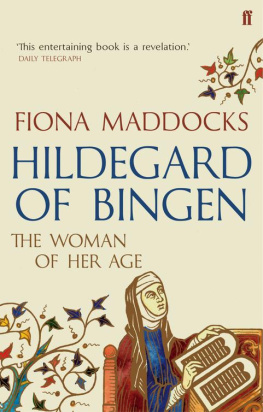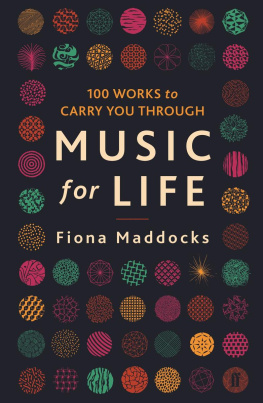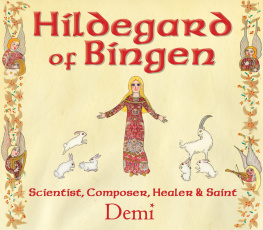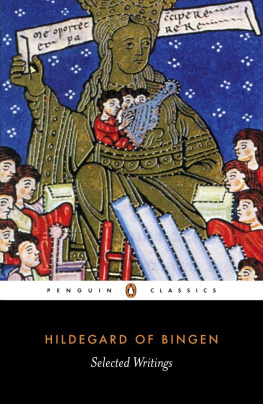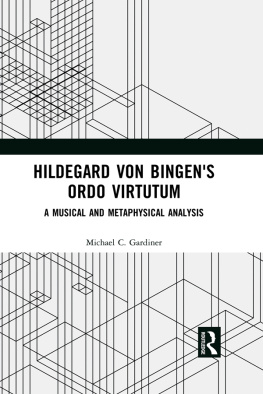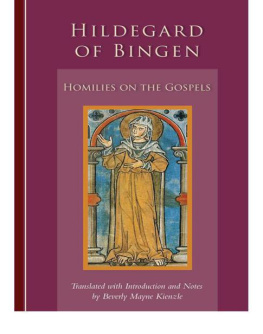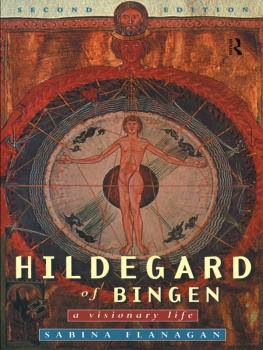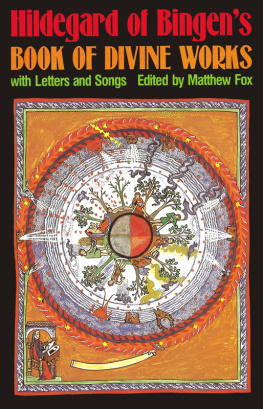Its never too late for sainthood. On 10 May 2012 Pope Benedict XVI endowed this holy status on Hildegard of Bingen more than eight hundred years after her death, when the idea of canonisation was first mooted. He had succeeded in cutting through Vatican red tape where others failed (outlined in the Relighting the Flame chapter of this book). Now it was official: Hildegard, long revered as a local saint in her native Germany, had joined the approved catalogue, extending her cult to the universal church.
The Pope had quoted Hildegard in the context of the Roman Catholic Churchs recent sex abuse scandal: In the vision of St Hildegard, the face of the Church is stained with dust Her garment is torn by the sins of priests. The way she saw and expressed it is the way we have experienced it this year. He also noted that her keen interest in the sciences was a natural extension of her spirituality, since in her eyes the entire creation is a symphony of the Holy Spirit. It was hardly surprising that Benedict, a German as well as an accomplished musician, would push for her official sanctity.
He went a step further. On 7 October 2012, he made her a Doctor of the Church, a title given to those whose writings or teachings have had a particular impact. There being only 35 in total, Hildegard is in exclusive company. Others include Saints Augustine, Thomas Aquinas, Catherine of Siena and her own great ally, Bernard of Clairvaux. This proved one of the last major decisions in Benedict XVIs pontificate.
So the fascination with Hildegard endures, her name cited at times of crisis, her reputation and extraordinary achievements ever better known to the world at large. Scholarly research continues; plays, films, recordings, compositions inspired by her chant have emerged in a steady stream since this book first appeared. I thank Belinda Matthews of Faber and Faber and my agent Felicity Bryan for their ingenuity and industry in bringing it to life again. Aside from modifications to the list of recommended CD recordings, the text remains the same as in the original.
Why read a book about Hildegard of Bingen? And why write one? One answer is enough: she was an extraordinarily gifted individual who, for all her apparent remoteness in time and place, illumines our own times and shines a light on the past. We can ask little more of history. This German abbesss power and influence seeped into every crevice of twelfth-century life. That she also happened to be a woman who only found her voice in mid-life merely adds to the richness of her story, though for others with a more directly feminist preoccupation that fact would be of critical importance.
Today she is best known for her music. Yet her compositions form only a small part of her story. She was a polymath: a visionary, a theologian, a preacher; an early scientist and physician; a prodigious letter writer who numbered kings, emperors and popes among her correspondents. She was an artist not only in the musical and literary sense but in painting and, it would seem, architecture. She even invented her own coded language. Her boldness, courage and tenacity made her at once enthralling and haughty, intrepid and irksome. By contrast, the ills and terrors caused by, or perhaps even causing, her spectacular and overwhelming visions often rendered her helpless and torpid.
Fortunately, since the twelfth century witnessed a flowering of scholarship, an extravagant amount of source material exists in the form of Hildegards own writings (still obscure to a general reader though helpful modern editions begin to emerge), her letters and contemporary biographical accounts. To avoid constant explanation of these important but drab sounding documents, I have listed them at the front of the book, together with a glossary of key people and places. Her works are listed with a short description in Appendix I. If only to avoid the Russian novel effect, I urge readers to glance at these at the start.
The task of encompassing her myriad spheres of interest only underlines my own inadequacies. Hundreds of books have already been written about her. With what entitlement does this present study appear? Ideally one should be a specialist in twelfth-century Germany, in medieval Latin and ecclesiastical history, in the history of science and medicine, botany and biology, mineralogy and petralogy, zoology and theology, mysticism, music, painting and monastic architecture.
Not surprisingly, scholars usually prefer to examine aspects of her life or work in depth, particularly her theology, while virtually ignoring the rest. A few, notably Peter Dronke at Cambridge, who first pioneered an interest in Hildegard in the English-speaking world in the 1970s, and more recently Barbara Newman in America and Sabina Flanagan in Australia have dared to pull together all the strands. Their work is warmly recommended. Still, each has his or her own strengths and obsessions.
At the other end of the spectrum, Hildegard has featured in steamy (or, rather, quietly simmering) novels, TV documentaries and anecdotal popular histories. These have their place but leave too many questions unanswered for the enquiring general reader. Moreover, as a quick look at the Internet shows, she has become the darling of crankish cults and New Age zealots, Creationists and Greens, womens movements and alternative doctors.
I have tried to steer a route between the extremes of fashionable enthusiasms and scholarly minutiae and have written instead with the freedom of one who simply enjoyed the quest and wanted to tell the story.
Thanks are due to Doug Young, who had the idea, and to Celia Kent at Headline for their endless patience and enthusiasm; also to Lavinia Trevor for making the connection. John Pull at the Library of Congress, Washington, first gave me a glimpse of the size of the enterprise by sending a list of Hildegard citations running to dozens of pages. So much for obscurity. Sister Benedicta Ward SLG, Reader in the History of Christian Spirituality at Harris Manchester College, Oxford, scrutinised the manuscript with painstaking attention. Her wit, sagacity and stern annotations saved me from many a scholarly slip but I am responsible for those which remain. She also made invaluable suggestions concerning the bibliography.
Professor Roderick Swanston, Reader in Historical and Interdisciplinary Studies at the Royal College of Music, London, chewed rigorously over the chapter on music and many stimulating suggestions offered. I have done my utmost to ackowledge all sources and attributions, but I apologise to any I may have overlooked. The staff at the Bodleian Library, Oxford, always tracked down the books I needed. Alice Wood pointed out connections between Hildegards medical writings and modern homeopathy. Francesca Currie read the manuscript at a late stage and asked some timely and penetrating questions which proved invaluable.
Sister Ancilla Feerling at the St Hildegard Abbey, Eibingen, allowed me to interview her and freely to publish the results. Those acquainted with the Catholic faith will find many of her observations about the world of a convent familiar. I have included them nevertheless (as an appendix) to demonstrate the continuity, and in some respects discontinuity, of the Benedictine vocation. Her decidedly unceremonious attitude towards her famous patron was of surprise and interest.
Especial thanks are due to my friends and family, who now know more about the quiddities of monastic life than is necessarily good for them. My children agreed to a summer holiday in Bingen when a beach (or indeed almost any other destination) might have appealed more. My husband, Tom Phillips, read and commented meticulously on the manuscript at each stage with a devotion way beyond the bounds of marital or editorial duty.

